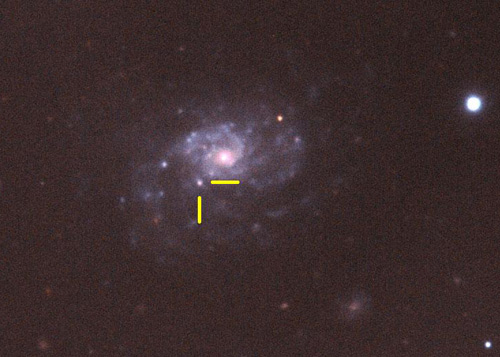Key Takeaways:
Gamma-ray bursts (GRBs) have been called the universe’s most explosive events since the Big Bang. The recent discovery of an asymmetrical supernova that probably beamed a GRB away from Earth strengthens, but does not yet prove, the connection between a stellar explosion called a type Ic supernova and still-mysterious GRBs.
Because astronomers have instruments in space to pinpoint GRBs, they have been able to find a strong correlation between long GRBs — those lasting more than 2 seconds — and highly energetic type Ic supernovae.
Astrophysicists Stan Woosley and Andrew MacFadyen first linked type Ic supernovae to GRBs in the late 1990s. Their theory involves massive stars that already have shed their outer layers of hydrogen and helium. When those stars — called collapsars — run out of nuclear fuel, they collapse catastrophically into neutron stars or black holes. If a star is spinning rapidly as it collapses, its flattened profile produces a non-spherical explosion, with jets of material spewing from its poles at near-light speeds. If one of these narrow jets points toward Earth, we see a gamma-ray burst.
Now, Paolo Mazzali, at Italy’s National Institute of Astrophysics in Trieste, and his colleagues have found that SN 2003jd, a type Ic supernova, shows just the kind of asymmetrical blast predicted by the collapsar model and probably produced a GRB. SN 2003jd lies 260 million light-years from Earth in the constellation Aquarius. Astronomers first observed the event October 25, 2003.
The star’s asymmetrical detonation showed up in spectra captured by the 8.2-meter Subaru Telescope and the 10-meter Keck Telescope, both atop Mauna Kea in Hawaii. Spectral lines denoting the presence of magnesium and neutral oxygen showed a split into two colors. These doubled lines imply the presence of high-velocity jets tilted about 70° from our line of sight.
“A prediction of the collapsar model is that such double-peaked oxygen emission lines should be seen in some type Ic supernovae, and now we’ve found an example,” Alex Filippenko, an astronomer at the University of California, Berkeley, and coauthor of the report in this week’s Science, tells Astronomy.
Schmidt agrees the finding is important because it indicates the mechanisms powering this type of supernova and GRBs may be the same. “It shows that the process which ripped apart the supernova is very similar to that which blows apart GRBs,” he tells Astronomy.
Still, without proof the supernova produced a GRB, SN 2003jd can’t cement the collapsar-GRB connection. Mazzali’s team still hopes to find telltale X rays or radio emissions as the jets they believe are there spread out. “Now is the best time for the observations,” says Ken’ichi Nomoto, a team member at the University of Tokyo. Although the signal may be detectable for another year, its strength will diminish over time.
Even without that final link, the observers are encouraged. “It is exciting to me that two initially disparate fields of high-energy astrophysics, namely supernovae and gamma-ray bursts, now show clear signs of being closely connected,” says Filippenko.










